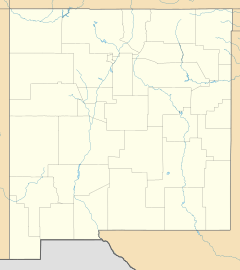Hagan, New Mexico facts for kids
Quick facts for kids
Hagan, New Mexico
|
|
|---|---|
| Country | United States |
| State | New Mexico |
| County | Sandoval |
| Population
(2000)
|
|
| • Total | 0 |
| Time zone | UTC-5 (Mountain (MST)) |
| • Summer (DST) | MDT |
| Area code(s) | 505 |
Hagan is a ghost town located in Sandoval County, New Mexico, United States. A ghost town is a place where most people have left, and few or no people live there anymore. Hagan is about 13 miles southeast of San Felipe Pueblo.
The Story of Hagan
Hagan began in 1902 when a company called New Mexico Fuel and Iron Company started to dig for coal there. The town was named "Hagan" in 1904, probably after an important person from the AT&SF Railroad. This was likely done to encourage the railroad to build a special track to the mines.
At first, workers had to carry the coal by wagon to the main railroad line in San Felipe. Building a railroad track to Hagan started in 1908, but it stopped after only a few months. This delay meant the small community of about 60 people couldn't grow much for ten years.
Building a Company Town
Things changed in 1919 when a businessman named Jean Justin DePraslin from New Orleans helped get a lot of money – almost $450,000 – to develop the Hagan Coal Mine. More money, about $300,000, was raised for a new railroad called the Rio Grande Eastern. This railroad line was finished in May 1924. Besides coal, the railroad also carried bricks and tiles from a factory near the ruins of Tonque Pueblo, a few miles north of Hagan.
DePraslin planned Hagan to be a big company town for 500 residents. A company town is a place where a company builds homes and stores for its workers. Over 100 buildings made of adobe (a type of sun-dried brick) were built by Abenicio Salazar and his team. They built these in the Pueblo Revival style, which was popular then. The town had electricity and running water, which was piped from a spring two miles away.
The main store was a two-story building that had a bank, a post office, a barber shop, and a pool hall. There was also an eight-grade school for 70 students.
Growth and Decline
Hagan grew between 1924 and 1930, and its population reached about 200 people. Most of these people were miners from places like Raton and Dawson, or local Hispanos from Madrid and Los Cerrillos.
However, in the early 1930s, the miners digging for coal hit a layer of shale (a type of rock). This shale layer grew wider and wider, making it hard to get coal out. By 1933, the railroad, which was never very profitable, stopped running and was taken apart. In 1939, the Hagan Mine finally closed down.
Hagan Today
Today, only the foundations and a few brick walls remain of the power plant, general store, and other buildings. You can see the site from Indian Service Road 844/Madera Road, which follows the old railroad path from San Felipe. However, the ruins are on private land owned by the Diamond Tail Ranch. This means they are usually not open to the public, except for special organized tours.



